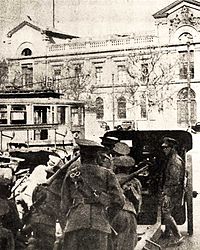- Seguro Obrero massacre
-
Seguro Obrero massacre 
Troops of the Regimiento Tacna pulling a cannon on the occupied University of Chile-BuildingDate 5 September 1938 Location Chile Result Chilean government victory Belligerents  Nacistas
Nacistas Government of Chile
Government of ChileCommanders and leaders  Jorge González von Marées
Jorge González von Marées Arturo Alessandri
Arturo AlessandriThe Seguro Obrero massacre (Spanish: Matanza del Seguro Obrero) was the Chilean government's response to an attempted coup d'état by the National Socialist Movement of Chile, whose members were known at the time as nacistas.
Contents
Background
The Seguro Obrero Massacre took place on September 5, 1938, in the midst of a heated three-way election campaign between the ultraconservative Gustavo Ross Santa María, the radical Popular Front's Pedro Aguirre Cerda, and the newly-formed Popular Alliance candidate, Carlos Ibáñez del Campo. The National Socialist Movement of Chile supported Ibáñez's candidacy, which had been announced on September 4. In order to preempt Ross's victory, the National Socialists mounted a coup d'état that was intended to take down the right wing government of Arturo Alessandri Palma and place Ibáñez in power.
September 5, 1938
At around 12:30 PM on Monday, September 5, 1938, approximately thirty armed youths affiliated with the National Socialist Movement (MSN) occupied the Seguro Obrero building. José Luis Salazar, a carabinero who was on watch, upon observing the situation, thought that the youths were concealing weapons under their coats, and prepared to respond. However, a member of the movement who observed the reaction of the serviceman started to fire, mortally wounding Salazar.
In reaction, a short while later a crowd of carabineros gathered at the foot of the building. Heavy firing between the opposing sides began. Gerald Gallmeyer, a National Socialist youth, was killed. His companions resisted, but the carabineros forces forced them to retreat.
In the meantime, another 32 youths had occupied the central building at the University of Chile. This also culminated in a shoot out, beginning at 2:00 AM, when an assault by the carabineros took members of the National Socialists crowd by surprise; those who surrendered were led with their hands up, toward the Seguro Obrero a few blocks away. There they were informed that the attempted coup had already failed, and were sent to convince their comrades to lay down the arms on the condition that their lives would be respected. The young people accepted the promise and laid down their weapons.
Although disarmed and captured, nearly 60 young people were then lined against a wall and shot, breaking the promise to respect their lives. Only four youths managed to escape death. The bodies of the youths were facially and bodily disfigured by deep wounds from sabers and bayonets.
It remains unclear who ordered the shootings. Some attested that Arturo Alessandri Palma dispatched a presidential order to "Kill them all!" Alessandri wanted it to be believed that the National Socialist had killed each other, but this allegation has been widely accepted as false. Nevertheless, the accusations against Alessandri are grounded in speculation rather than tangible evidence. There is no official history relating to this subject; it is and will continue to be highly controversial among historians.
Testimony
Many were killed on that day, including workers, clerks, lawyers, and students. Among them was Bruno Bruning Schwarzenberg, a 27-year-old accounting student at the Catholic University. His story was related by a carabinero who was on duty:
I stood guard near the corpses. Suddenly, I saw that one of the bodies was moving. It was a blond, very pale young man, with clear blue eyes. I told him not to move. An officer scolded me, 'Perhaps you are trying to save him!' He fired at the wounded young man who fell on his side and, looking pointedly at the officer with those clear eyes, exclaimed: 'I die at peace with the Fatherland!'
While there are a great number of stories told about that day, undoubtedly one of the best-known is that of 19-year-old Pedro Molleda Ortega. While the carabineros tended to the wounded, he rose, shouting "Long Live Chile!" to which an official responded by shooting him at point-blank range. In spite of being wounded, Molleda attempted to arise and shouted with force "It does not matter, comrades. Our blood will save Chile." At this point, the harassed official attacked with saber strokes, leaving Molleda in pieces. Today "Our blood will save Chile" is the rallying cry among National-Socialists in Chile.
See also
- List of massacres in Chile
- Jorge González von Marées
- Carlos Ibáñez del Campo
- Chilean political scandals
- History of Chile
External links
- Martyrs of the Seguro Obrero - The National-Socialist Movement's listing, with brief obituaries and photographs (Spanish)
- TIME article on the political aftermath
Categories:- Conflicts in 1938
- Presidential Republic
- Political scandals in Chile
- Massacres in Chile
- Deaths by firearm in Chile
- 1938 in Chile
- Nazism
- Attempted coups
Wikimedia Foundation. 2010.
